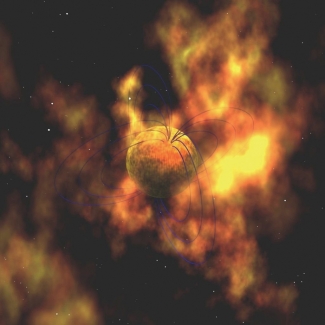What do fermions in atomic nuclei, neutron stars, and ultracold trapped gases have in common? They have the same fundamental behavior. The exciting news is that there's now hard evidence that this is true, thanks to graduate students Jayson Stewart and John Gaebler, Cindy Regal who received her Ph.D. in physics in November, and Fellow Debbie Jin.
Jin says that many of us might expect the behavior of an ultracold trapped gas of fermions to depend on the interactions between the fermions (or how they "feel" each other). But, ironically, if these interactions are extremely strong, then they no longer matter; under such conditions, the behavior of the gas depends only on temperature and density.
In a recent experiment, the Jin group measured the potential energy of an ultracold trapped gas of 40K atoms in the crossover region between Bose-Einstein condensation and superconductivity/superfluidity. The researchers used a magnetic Feshbach resonance to maximize the intensity of the interatomic interactions and found that an attraction between the atoms caused them to become more tightly packed.
They then studied the effect of temperature on the ratio of the potential energy of their strongly interacting gas to that of a noninteracting gas. By extrapolating the ratio to a temperature of 0 K, they were able to extract a universal (many-body) parameter ß and determine its value. Their experimental value of -0.54 was consistent with previous measurements of 6Li atoms, recent crossover theory developed at JILA, and Monte Carlo calculations. (Monte Carlo calculations use many calculations starting with random numbers to produce solutions to problems that are otherwise too difficult to solve.)
This work proved that the universal parameter β is not specific to 6Li atoms; rather it is characteristic of any Fermi gas, neutron star, or atomic nucleus. From now on, researchers in the Jin group are confident that the results of their experiments on 40K atoms reflect general properties of fermions, not just those of a particular atom. - Julie Phillilps




